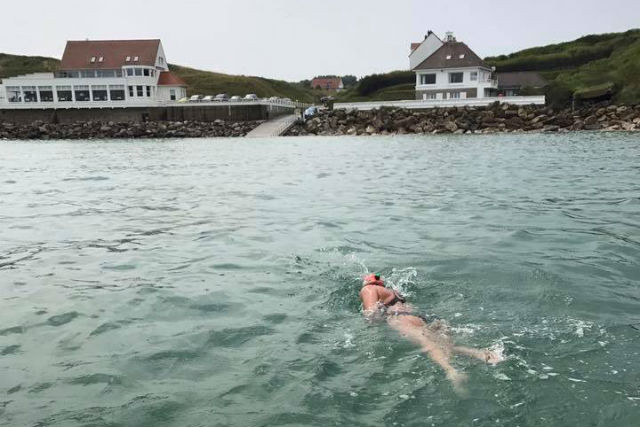Jess Bauldry: What made you decide to take up this challenge?
Paule Kremer: I used to do triathlon and duathlons before starting this crazy project. A friend of mine asked if I wanted to join a relay team last year. He tried to cross the channel twice but was unsuccessful.
I said “yes”. I never thought I would try to do it alone. When we had returned to Dover, I asked our pilot if he had any available slots.
You must be a very good swimmer.
Actually, no. Swimming was always my weakest. I did duathlons because there was no swimming. I had to concentrate on swimming. I’ve improved now, obviously. That was the hardest bit: getting the technique right and having an efficient technique.
So, did everything go to plan?
Each swimmer gets a tide: a neap or a spring tide. My pilot takes swimmers on the neap because the currents are weaker. My window had actually gone. It was for 29 July to 6 August. Because I had been staying in Folkestone for so long, he suggested taking me on a spring tide but told me to be aware the current will take me further out.
We were waiting eight to nine days until I knew I could finally go. That was mentally the hardest bit. We decided to go at night because it was calm with no wind whatsoever.
You ended up swimming 59 kilometres when the stretch is 32. Why is that?
No-one manages to do 32 km because the currents take you further away. I swam in an s shaped curve. Each bit of the curve is one current.

Photo: Paule Kremer, English teacher and Luxembourger Paule Kremer raises a glass after swimming across the English channel
What was the hardest part?
The beginning. I threw up, I was weak and wasted so much energy. By 2am I had swum 4 hours and I was tired. Then they gave me a coffee with I don’t know how many sugars and after that I was fine.
What was going through your mind when you finally arrived?
Knowing I had landed where I had, I was quite happy because the owner of the restaurant [at Cape Gris Nez, France] gives you a glass of champagne. People had told me about that. I didn’t realise I was landing there until I saw him watching with a glass. I didn’t realise I had just swum the channel. When I got on the boat people were crying. I was happy and tired. I still haven’t realised. It’s slowly sinking in.
Were you surprised by the public’s response to what you achieved?
I was. My crew had a little white board for me. They wrote messages on there for me to read during my swim. They suddenly said: “you’ve exploded on Facebook!”. One person was putting updates on how I was doing. They had to recharge my phone twice on the boat because so many people wrote to me. I didn’t know the response was so huge, even now. I’m overwhelmed by everything!
You did this to raise money and awareness about Plooschter Projet. Tell us more about this.
It was founded by a friend of mine who was diagnosed with leukemia. He decided to raise awareness for people to become stem cell donors. In Luxembourg, it’s hard to get people. I think now that the data base is growing. I think I raised €8,000 and I’m happy with that. We aimed for €10,000 and I never thought we would get that close.
What’s next for you?
I don’t know. Have a rest for a couple of days. I don’t know whether I will do another swim or get back into triathlon.
